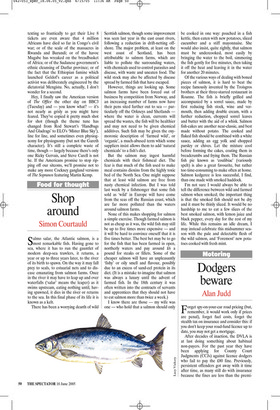Shop around
Simon Courtauld
Salmo salar, the Atlantic salmon, is a most remarkable fish. Having gone to sea, where it has to run the gauntlet of modern deep-sea trawlers, it returns, a year or up to three years later, to the river of its birth to spawn. On the way it may fall prey to seals, to estuarial nets and to disease emanating from salmon farms. Once in the river it may have to leap up and over waterfalls (‘salar’ means the leaper) as it swims upstream, eating nothing until, having spawned, it dies in the river or returns to the sea. In this final phase of its life it is known as a kelt.
There has been a worrying dearth of wild Scottish salmon, though some improvement was seen last year in the east coast rivers, following a reduction in drift-netting offshore. The major problem, at least on the west coast of Scotland, has been attributable to salmon farms, which are liable to pollute the surrounding waters, with chemicals used to control parasites and disease, with waste and uneaten food. The wild stock may also be affected by disease spread by farmed fish that have escaped.
However, things are looking up. Some salmon farms have been forced out of business by competition from Norway, and an increasing number of farms now have their pens sited further out to sea — particularly off the Orkneys and Shetlands where the water is clean, currents will spread the wastes, the fish will be healthier and may not need to be given chemical additives. Such fish may be given the oxymoronic description of ‘farmed wild’, or ‘organic’, a much-abused term which some suppliers insist allows them to add ‘natural chemicals’ to a fish’s diet.
But the salmon may ingest harmful chemicals with their fishmeal diet. The fear is that much of the fish used to make meal contains dioxins from the highly toxic bed of the North Sea. One might suppose that at least wild salmon are free from nasty chemical infection. But I was told last week by a fishmonger that some fish sold as ‘wild’ in Europe will have come from the seas off the Russian coast, which are far more polluted than the waters around salmon farms.
None of this makes shopping for salmon a simple exercise. Though farmed salmon is not as cheap as it was, the wild fish may still be up to five times more expensive — and it will be hard to convince oneself that it is five times better. The best bet may be to go for the fish that has been farmed in open, northerly waters and pay around £6 a pound for steaks or fillets. Some of the cheaper salmon will have an unpleasantly ‘fishy’ or oily smell and flavour, possibly due to an excess of sand-eel protein in its diet. (It is a mistake to imagine that salmon was always a luxury until the advent of farmed fish. In the 18th century it was often written into the contracts of servants and apprentices that they should not have to eat salmon more than twice a week.) I know there are those — my wife was one — who hold that a salmon should only be cooked in one way: poached in a fish kettle, then eaten with new potatoes, sliced cucumber and a stiff mayonnaise. She would also insist, quite rightly, that salmon must be undercooked, most easily by bringing the water to the boil, simmering the fish gently for five minutes, then taking it off the heat and leaving it in the water for another 20 minutes.
Of the various ways of dealing with boned pieces of salmon, it is hard to beat the recipe famously invented by the Troisgros brothers at their three-starred restaurant in Roanne. The fish is briefly grilled and accompanied by a sorrel sauce, made by first reducing fish stock, wine and vermouth, then adding double cream, with a further reduction, chopped sorrel leaves and butter with the aid of a whisk. Salmon fish-cakes are another near-classic, and best made without potato. The cooked and flaked fish should be combined with a white sauce, adding an egg yolk and chopped parsley or chives. Let the mixture cool before forming the cakes, coating them in breadcrumbs and frying them. The Russian fish pie known as ‘coulibiac’ (variously spelt) is also a great favourite, but rather too time-consuming to make often at home. Salmon kedgeree is less successful, I find, than one made with smoked haddock.
I’m not sure I would always be able to tell the difference between wild and farmed salmon when smoked; the important thing is that the smoked fish should not be dry and it must be thinly sliced. It would be no hardship to me to eat a few slices of the best smoked salmon, with lemon juice and black pepper, every day for the rest of my life. While this remains an idle dream, I may instead celebrate this midsummer season with the pale and delectable flesh of the wild salmon, and ‘Foremost’ new potatoes cooked with fresh mint.
















































 Previous page
Previous page